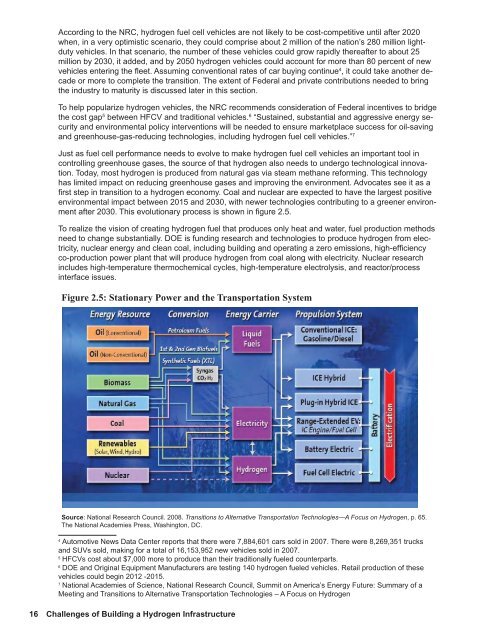Challenges - Research and Innovative Technology Administration ...
Challenges - Research and Innovative Technology Administration ...
Challenges - Research and Innovative Technology Administration ...
Create successful ePaper yourself
Turn your PDF publications into a flip-book with our unique Google optimized e-Paper software.
According to the NRC, hydrogen fuel cell vehicles are not likely to be cost-competitive until after 2020<br />
when, in a very optimistic scenario, they could comprise about 2 million of the nation’s 280 million lightduty<br />
vehicles. In that scenario, the number of these vehicles could grow rapidly thereafter to about 25<br />
million by 2030, it added, <strong>and</strong> by 2050 hydrogen vehicles could account for more than 80 percent of new<br />
vehicles entering the fleet. Assuming conventional rates of car buying continue 4 , it could take another decade<br />
or more to complete the transition. The extent of Federal <strong>and</strong> private contributions needed to bring<br />
the industry to maturity is discussed later in this section.<br />
To help popularize hydrogen vehicles, the NRC recommends consideration of Federal incentives to bridge<br />
the cost gap 5 between HFCV <strong>and</strong> traditional vehicles. 6 “Sustained, substantial <strong>and</strong> aggressive energy security<br />
<strong>and</strong> environmental policy interventions will be needed to ensure marketplace success for oil-saving<br />
<strong>and</strong> greenhouse-gas-reducing technologies, including hydrogen fuel cell vehicles.” 7<br />
Just as fuel cell performance needs to evolve to make hydrogen fuel cell vehicles an important tool in<br />
controlling greenhouse gases, the source of that hydrogen also needs to undergo technological innovation.<br />
Today, most hydrogen is produced from natural gas via steam methane reforming. This technology<br />
has limited impact on reducing greenhouse gases <strong>and</strong> improving the environment. Advocates see it as a<br />
first step in transition to a hydrogen economy. Coal <strong>and</strong> nuclear are expected to have the largest positive<br />
environmental impact between 2015 <strong>and</strong> 2030, with newer technologies contributing to a greener environment<br />
after 2030. This evolutionary process is shown in figure 2.5.<br />
To realize the vision of creating hydrogen fuel that produces only heat <strong>and</strong> water, fuel production methods<br />
need to change substantially. DOE is funding research <strong>and</strong> technologies to produce hydrogen from electricity,<br />
nuclear energy <strong>and</strong> clean coal, including building <strong>and</strong> operating a zero emissions, high-efficiency<br />
co-production power plant that will produce hydrogen from coal along with electricity. Nuclear research<br />
includes high-temperature thermochemical cycles, high-temperature electrolysis, <strong>and</strong> reactor/process<br />
interface issues.<br />
Figure 2.5: Stationary Power <strong>and</strong> the Transportation System<br />
Source: National <strong>Research</strong> Council. 2008. Transitions to Alternative Transportation Technologies—A Focus on Hydrogen, p. 65.<br />
The National Academies Press, Washington, DC.<br />
4<br />
Automotive News Data Center reports that there were 7,884,601 cars sold in 2007. There were 8,269,351 trucks<br />
<strong>and</strong> SUVs sold, making for a total of 16,153,952 new vehicles sold in 2007.<br />
5<br />
HFCVs cost about $7,000 more to produce than their traditionally fueled counterparts.<br />
6<br />
DOE <strong>and</strong> Original Equipment Manufacturers are testing 140 hydrogen fueled vehicles. Retail production of these<br />
vehicles could begin 2012 -2015.<br />
7<br />
National Academies of Science, National <strong>Research</strong> Council, Summit on America’s Energy Future: Summary of a<br />
Meeting <strong>and</strong> Transitions to Alternative Transportation Technologies – A Focus on Hydrogen<br />
16 <strong>Challenges</strong> of Building a Hydrogen Infrastructure

















